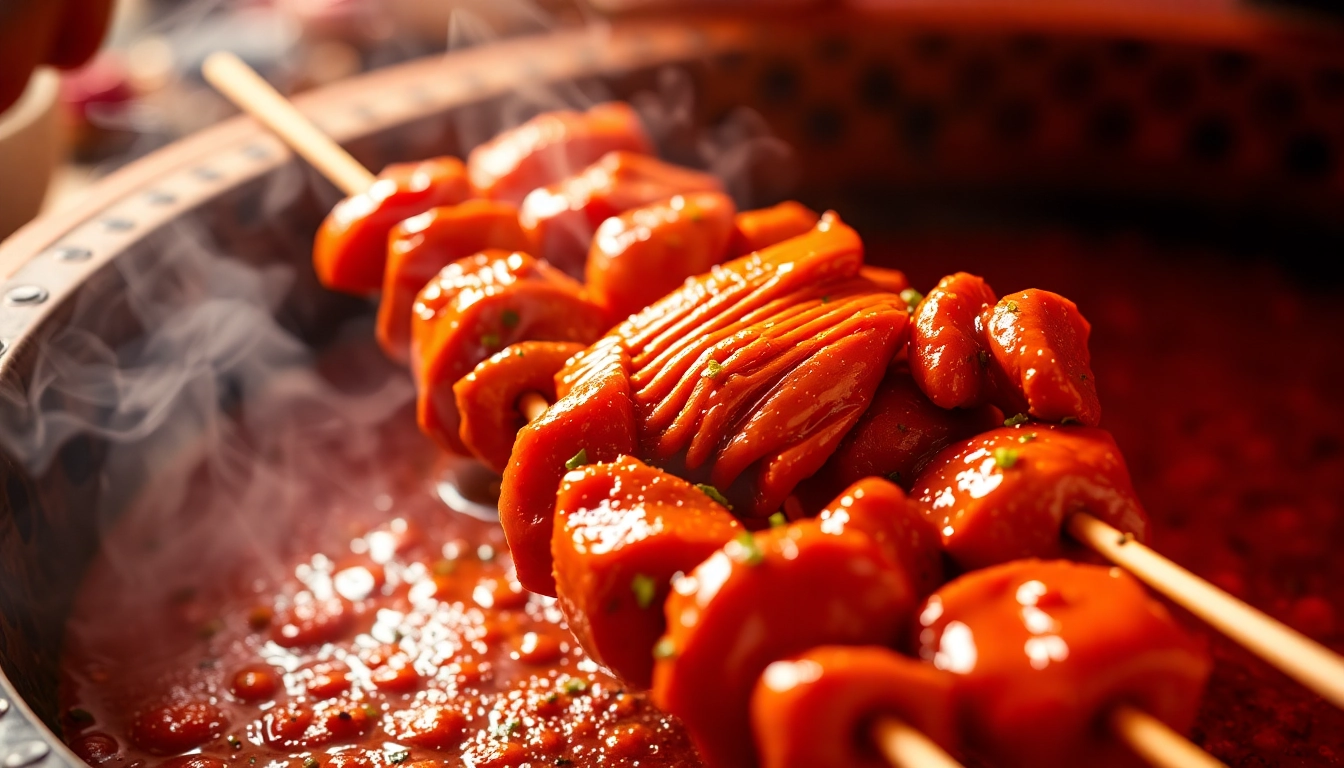
Mastering the Art of Tandoori Paste for Authentic Indian Grilled Dishes
Introduction to Tandoori Paste: Origins and Characteristics
Tandoori paste is a cornerstone of Indian cuisine, renowned for its vibrant color, rich aroma, and complex flavor profile. This versatile marinade forms the foundation for a variety of dishes, most famously the iconic tandoori chicken. Originating from North India, particularly Punjab, the art of preparing and using tandoori paste has evolved over centuries, blending traditional spice mixes with regional influences to create a unique culinary experience. Today, it is globally celebrated, embodying the essence of Indian spices through a harmonious blend of ingredients that deliver both taste and visual appeal.
At its core, Tandoori Paste is characterized by its bright red hue, which traditionally comes from natural ingredients such as red chili powder, turmeric, and sometimes food colorings. The paste also includes ingredients like garlic, ginger, yogurt, lemon juice, and various aromatic spices such as cumin, coriander, and garam masala. The combination of these elements not only imparts a signature smoky and tangy flavor but also tenderizes the meat, making it succulent and flavorful. Authentic tandoori paste is fermented or marinated for hours to enhance the depth of flavor and authenticity.
Historical Significance of Tandoori Paste in Indian Cuisine
Historically, tandoori paste is rooted in the traditional use of the tandoor oven, a clay furnace that has been used in India for thousands of years. The word “tandoori” itself derives from “tandoor,” signifying the method of cooking as well as the marinade used. The advent of the tandoori cooking style dates back to ancient Indian culinary practices, where marinating meats and vegetables with spice mixtures and yogurt was a way to preserve food and enhance flavor.
Its rise to global culinary prominence was catalyzed by Indian chefs and restaurateurs, especially in the mid-20th century, who introduced the method to Western audiences. The famous “Tandoori Chicken” was popularized in the UK and North America, making the paste a household staple for creating authentic Indian-style grilled dishes. Over time, the recipe and preparation techniques have diversified but remain true to the original principles of spice balance and marination.
Key Ingredients and Flavor Profile of Authentic Tandoori Paste
Authentic tandoori paste features a precisely balanced mix of spices and core ingredients that work synergistically to produce its characteristic flavor. The primary elements include:
- Red chili powder: Provides heat and the distinctive red color.
- Turmeric: Adds warmth and a golden hue, with anti-inflammatory benefits.
- Ginger and garlic: Offer pungency and depth, acting as natural flavor enhancers.
- Cumin and coriander: Contribute earthy, citrusy notes.
- Garam masala: A blend of spices adding warmth and complexity.
- Lemon juice and yogurt: Provide tanginess and assist in tenderizing the meat.
- Aromatic herbs and spices: Such as fenugreek, cardamom, and cloves, for nuanced flavors.
The flavor profile of authentic tandoori paste is smoky, spicy, slightly tangy, and rich in aromatic layers. Its robust nature makes it ideal for marinating meats like chicken, fish, or lamb, as well as vegetables, resulting in a vibrant flavor and aroma that is unmistakably Indian.
Difference Between Commercial and Handmade Tandoori Pastes
Choosing between commercial and handmade tandoori pastes significantly impacts culinary results. Commercial products are produced on a large scale, offering convenience and consistent flavor, but they often contain preservatives, artificial colors, and flavor enhancers to prolong shelf life. These formulations may lack the depth of flavor found in authentic, handmade pastes.
Handmade tandoori pastes, typically crafted by skilled artisans or local producers like Spice Nest, use natural ingredients and traditional methods. This results in a fresher, more nuanced flavor profile with higher nutritional value. Handmade pastes might vary slightly batch-to-batch, reflecting regional spice preferences and ingredient quality, but they consistently deliver superior taste and aroma. For culinary purity and health considerations, many chefs and home cooks prefer handmade options, especially when aiming for authentic results.
In essence, the choice hinges on convenience versus authenticity. For premium dishes, artisanal handmade pastes are recommended, while commercial options are suitable for quick preparation or large-scale cooking without compromising quality significantly.
Choosing the Right Tandoori Paste for Your Recipes
Types of Tandoori Paste Based on Spice Blends
Modern markets offer a variety of tandoori pastes tailored to different spice blends and flavor intensities. Some common types include:
- Classic Tandoori Paste: The traditional mix featuring red chili, turmeric, garlic, ginger, and yogurt.
- Spicy Variants: Extra chili or peppercorns for those seeking a fiery kick.
- Herb-Infused Pastes: Incorporating mint or coriander for a fresh twist.
- Vegan or Dairy-Free Pastes: Significant for dietary restrictions, omitting yogurt or using plant-based alternatives.
Factors to Consider When Selecting Quality Tandoori Paste
When selecting a high-quality tandoori paste, consider:
- Ingredient Purity: Natural spices without artificial additives or preservatives.
- Color: Vibrant red from natural sources rather than synthetic dyes.
- Aroma and Flavor: Rich, spicy, and aromatic, indicative of authentic spice blends.
- Packaging: Airtight, hygienic containers preventing contamination and maintaining freshness.
- Certification & Origin: Certified organic or quality assurance labels, and transparent sourcing, especially from reputed manufacturers like Spice Nest.
Top Brands and How to Identify Authentic Products
Leading brands differentiate themselves through transparency and adherence to traditional recipes. Look for brands that:
- Specify ingredient sources and natural spice blends.
- Have positive reviews emphasizing flavor authenticity.
- Provide certifications such as ISO, HACCP, or organic labels.
- Offer consistent quality across batches.
Spice Nest, for example, stands out due to its presence at major food exhibitions and commitment to quality manufacturing, ensuring genuine and flavorful products that meet international standards.
Tips for Cooking with Tandoori Paste
Marination Techniques for Tender and Flavorful Results
Effective marination is crucial for achieving the best possible flavor and texture. For tandoori dishes, follow these steps:
- Use a generous amount of tandoori paste; typically, 2-3 tablespoons per 500 grams of meat.
- Add acidic elements like lemon juice or yogurt to enhance tenderness.
- Marinate for a minimum of 4 hours; for deeper flavor, marinate overnight in the refrigerator.
- Ensure the marinade coats all surfaces evenly for uniform cooking.
Optimal Cooking Methods: Grilling, Baking, and Pan-Frying
While traditionally cooked in a tandoor, modern methods include:
- Grilling: Preheat grill to medium-high heat, cook marinated meat for 15-20 minutes, turning occasionally to develop that smoky char.
- Baking: Use an oven at 200°C (392°F), place meat on a wire rack, and bake for 20-25 minutes or until cooked through.
- Pan-frying: Sear on high heat for 2-3 minutes per side, then reduce heat and cook until tender.
Recipe Ideas Incorporating Tandoori Paste for Diverse Meals
Besides classic chicken tikka, consider creative variations:
- Vegetable skewers marinated with tandoori paste for a colorful vegetarian dish.
- Seafood such as fish or shrimp for a quick, flavorful appetizer.
- Tandoori-inspired wraps or sandwiches using grilled meats or vegetables.
Health Benefits and Nutritional Aspects of Tandoori Paste
Rich in Spices with Anti-inflammatory Properties
The array of spices in tandoori paste offers numerous health benefits. Ingredients like turmeric contain curcumin, renowned for its anti-inflammatory and antioxidant properties. Garlic and ginger further enhance immune support and aid digestion. Regular consumption of such spice blends can contribute to overall health and wellness.
Using Tandoori Paste for a Balanced and Flavorful Diet
Incorporating tandoori paste into meals can promote a balanced diet rich in herbs and spices, reducing the need for excessive salt or artificial flavorings. It encourages the intake of nutrient-dense ingredients, supporting digestive health and metabolic processes.
Allergy Considerations and Dietary Restrictions
Individuals with spice allergies or dairy intolerances should opt for formulations that omit common allergens, such as artificial colorings or dairy content. Many manufacturers, including Spice Nest, offer tailored options to accommodate diverse dietary needs.
Integrating Tandoori Paste into Your Culinary Business
Creating Signature Dishes with Tandoori Paste for Restaurants
For restaurateurs, developing signature dishes featuring tandoori paste can establish a unique culinary identity. Offering innovation, such as tandoori-marinated seafood or fusion dishes, can attract a broader customer base. Emphasizing authentic flavor and presentation enhances dining experiences.
Mass Production Tips for Exporters and Manufacturers
To ensure consistency in large-scale production, invest in high-quality sourcing of spices, precise blending techniques, and rigorous quality control measures. Automation and standardized recipes help maintain flavor integrity. Packaging innovations like vacuum sealing prolong shelf life and preserve aroma.
Marketing Strategies for Promoting Tandoori-Based Products
Effective marketing involves highlighting authenticity, quality certification, and health benefits. Engaging storytelling about traditional recipes and regional origins appeals to modern consumers seeking genuine flavors. Participating in food exhibitions like Biofach or FIE are excellent opportunities to showcase products and build international partnerships.
